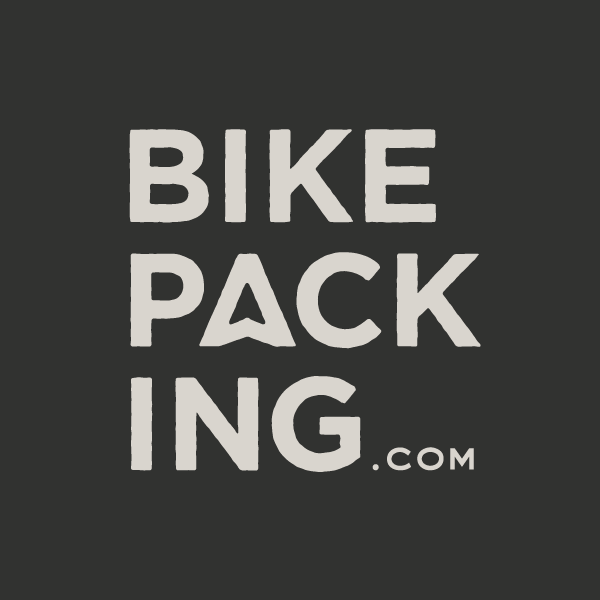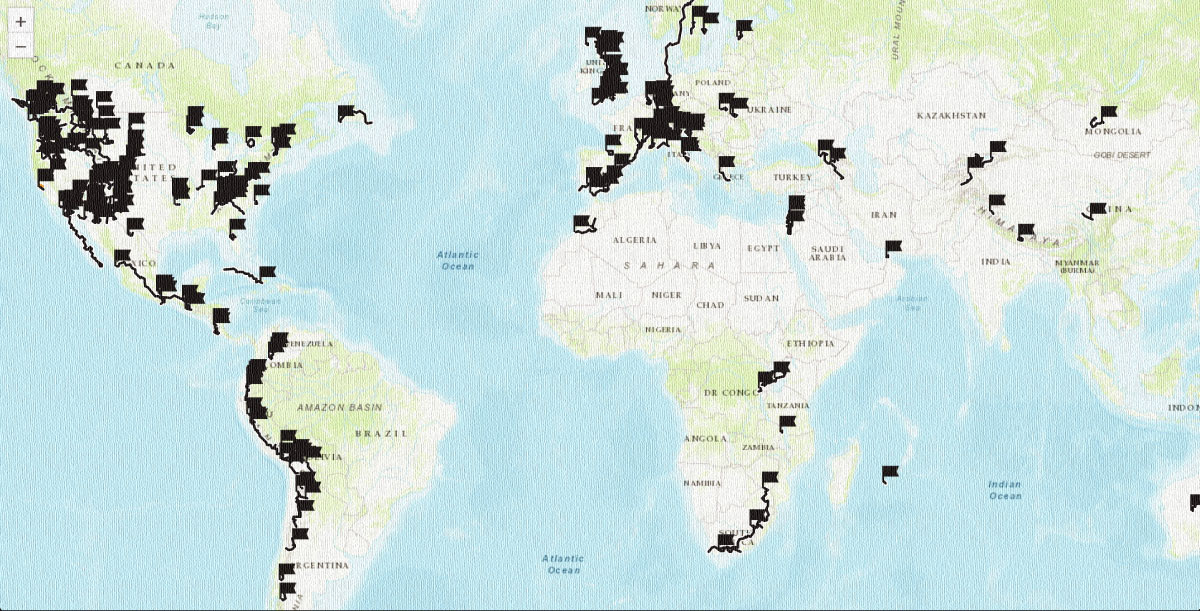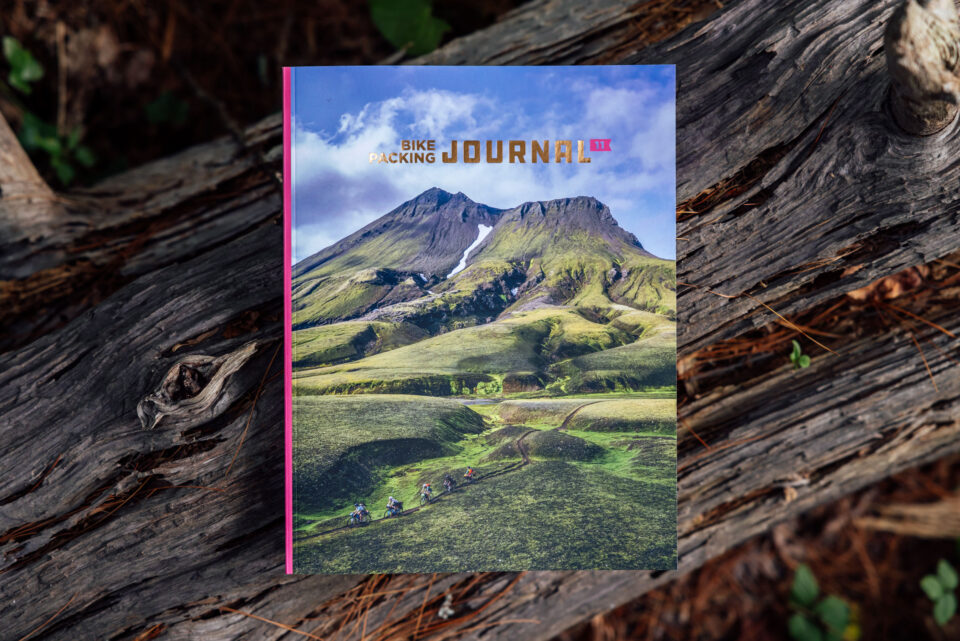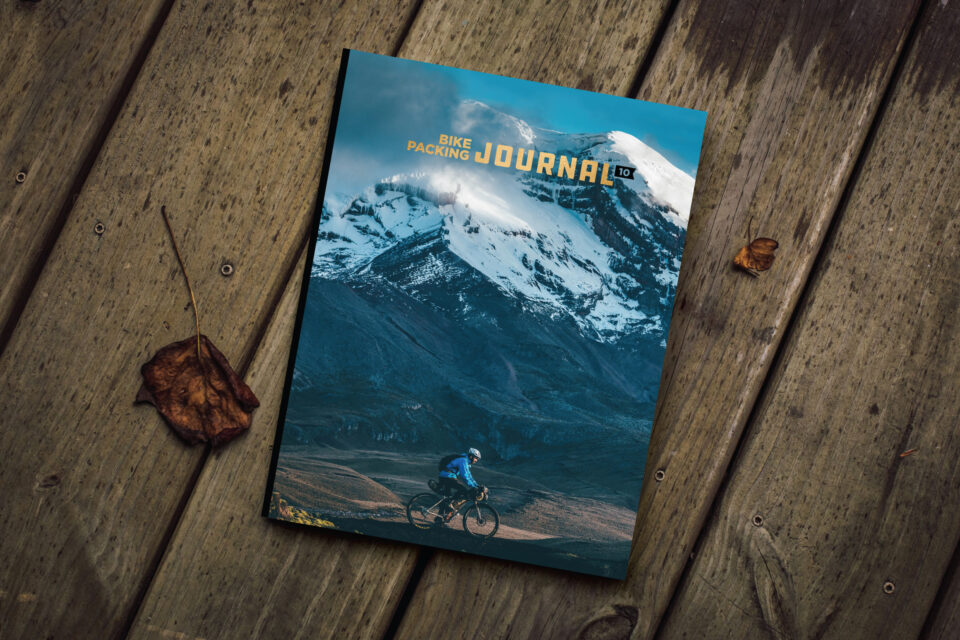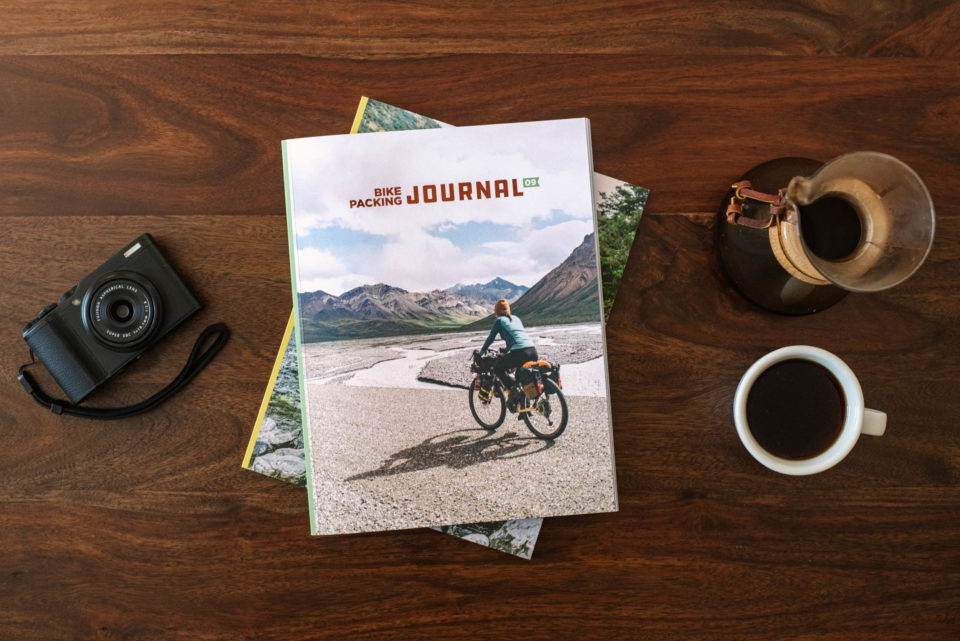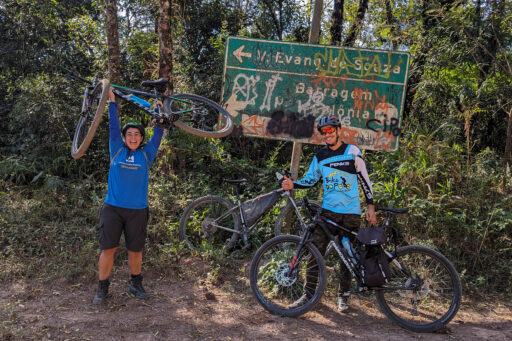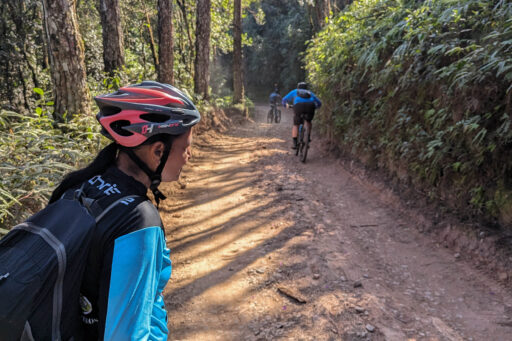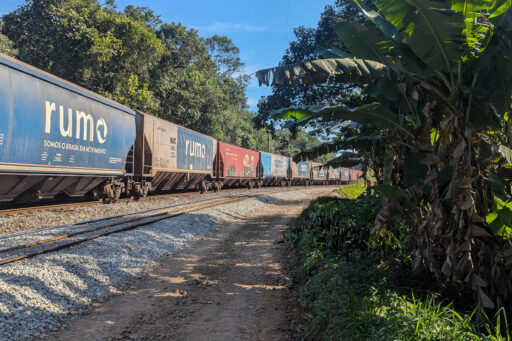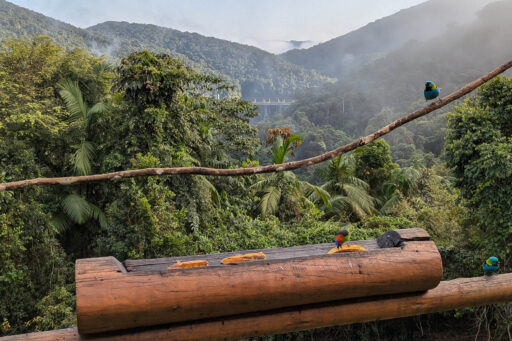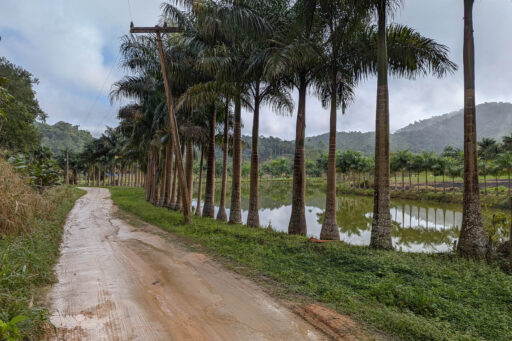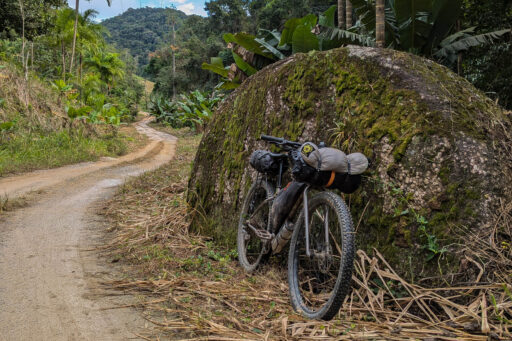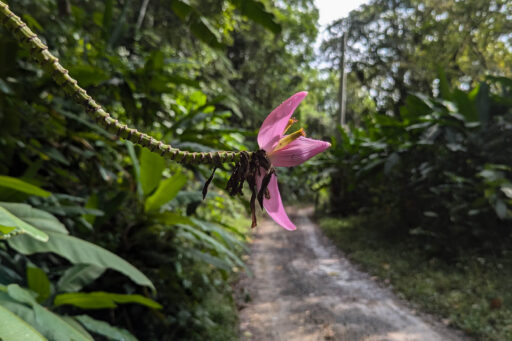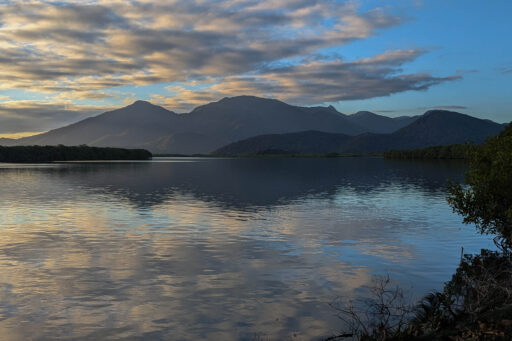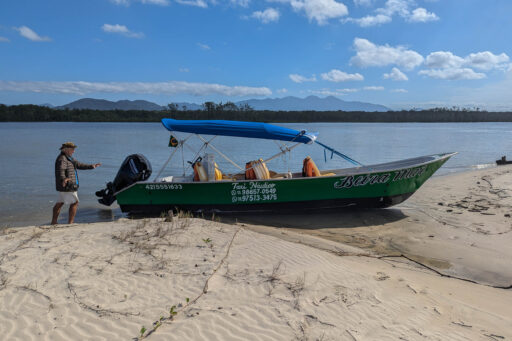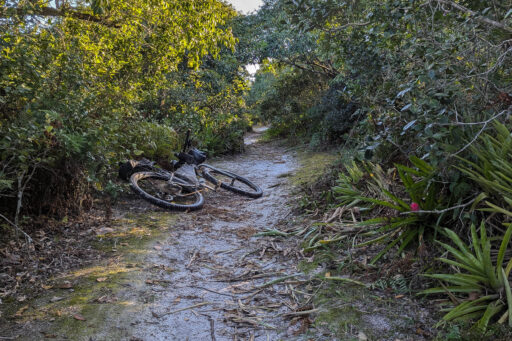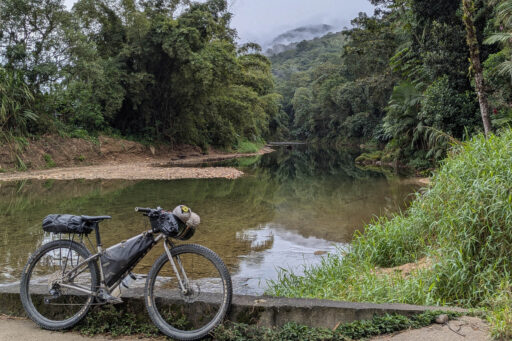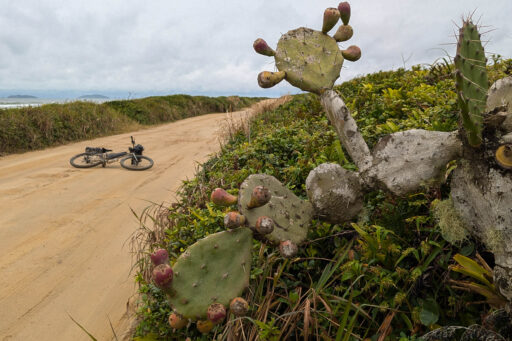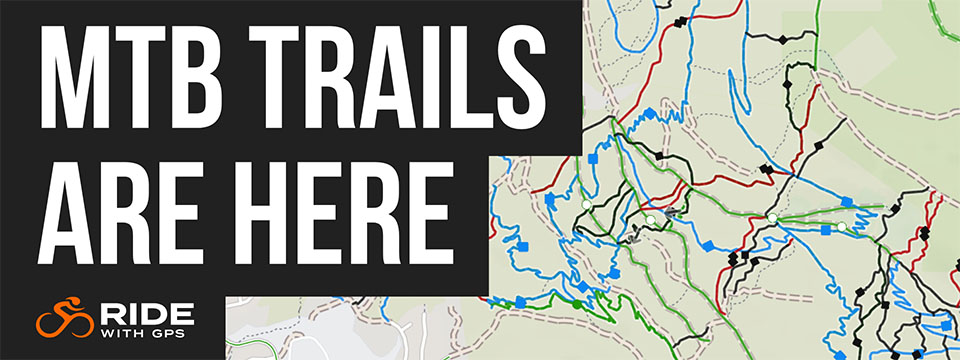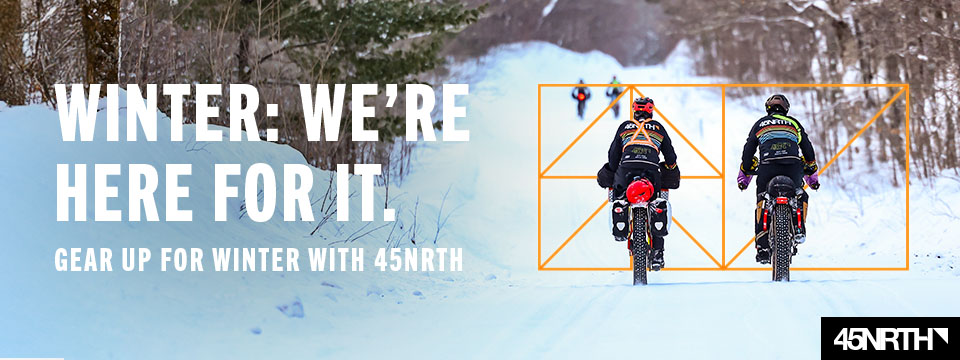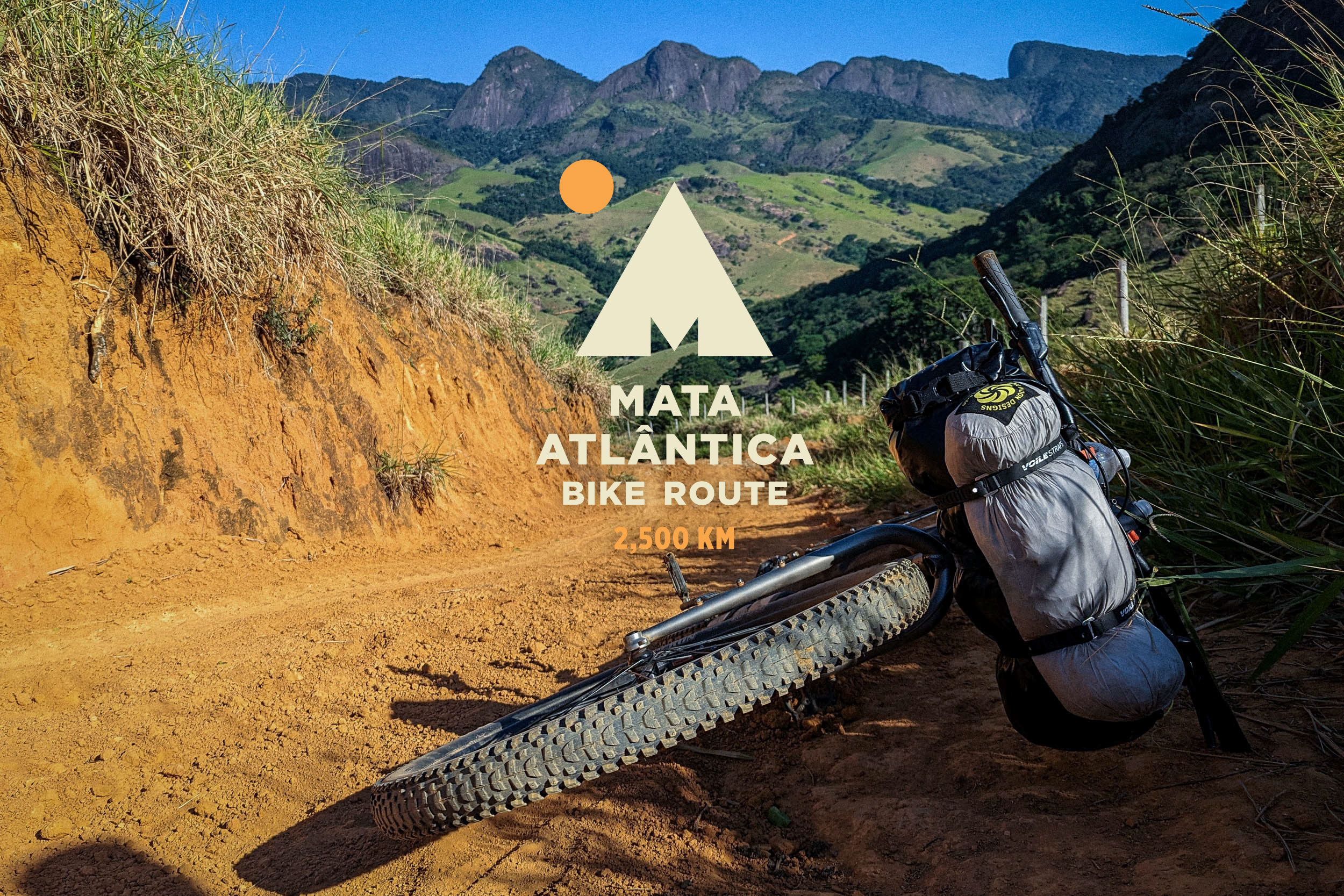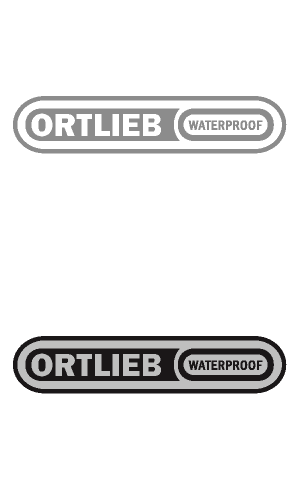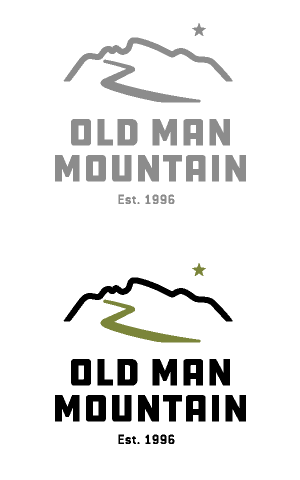Mata Atlantica Bike Route (S3): Lagamar
Distance
429 Mi.
(690 KM)Days
10
% Unpaved
85%
% Singletrack
1%
% Rideable (time)
99%
Total Ascent
26,534'
(8,088 M)High Point
2,755'
(840 M)Difficulty (1-10)
5?
- 4Climbing Scale Fair62 FT/MI (12 M/KM)
- 4Technical Difficulty Fair
- 5Physical Demand Moderate
- 7Resupply & Logistics Strenuous

Contributed By
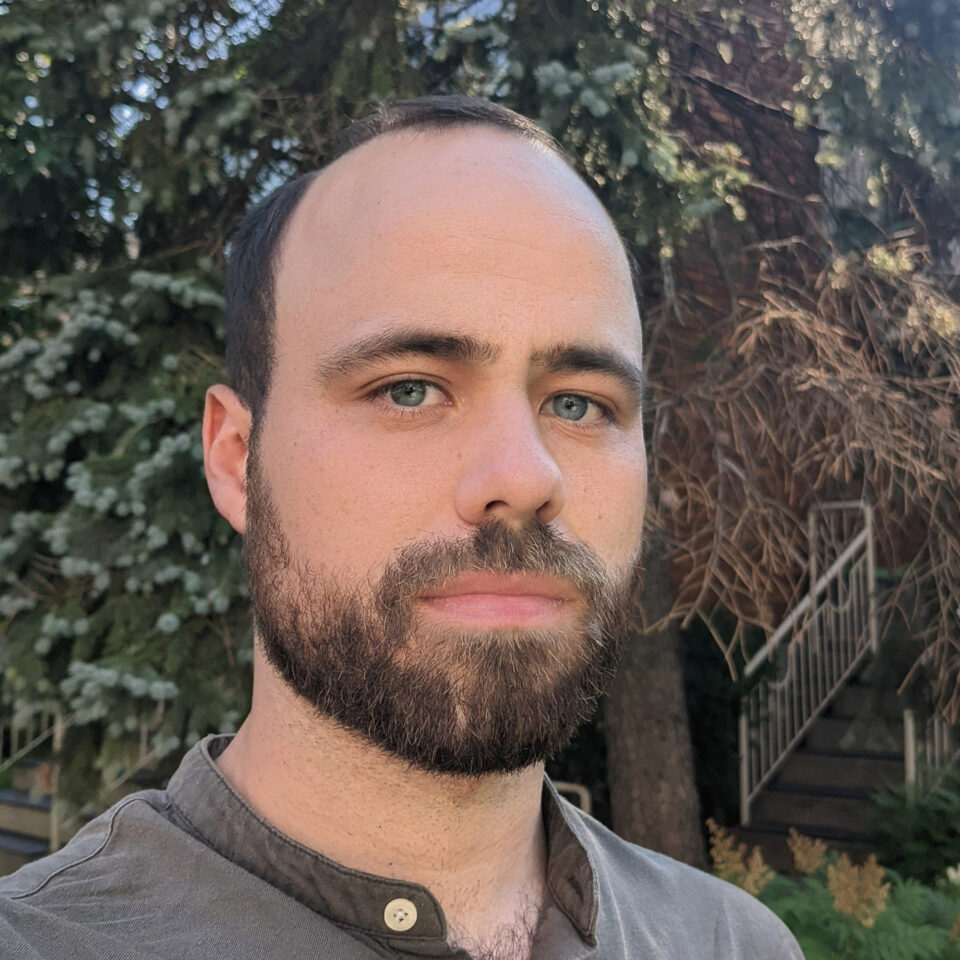
Alex Gauthier
Guest Contributor
Alex cycled exclusively for commuting in his hometown of Montreal until discovering bikepacking. To combine this new hobby with his lifelong passion for Latin America, he created the Mata Atlântica Bike Route in Brazil. He shares his travels on Instagram @alex.g.526.
The Mata Atlântica Bike Route (MABR) stretches over 2,500 kilometers from Rio de Janeiro to Rio Grande do Sul, tracing mostly unpaved roads and paths through five Brazilian states. Inspired by the Caminho da Mata Atlântica long-distance trail, it follows the Serra do Mar mountains, connecting protected remnants of the Atlantic Forest—one of the world’s most biodiverse regions—while passing through landscapes of tropical forests, canyons, plateaus, and beaches. Along the way, riders encounter traditional communities, historic towns, and a mosaic of cultures, with opportunities to spot iconic wildlife and experience the region’s incredible natural beauty. Find all the segments here.
The segment starts in the forest south of São Paulo. It makes its way west through the Jurupará State Park and Legado das Águas private reserve, where it follows the Juquiá River. It then descends to the Ribeira Valley and its banana plantations. It reaches the sea near the historic town of Cananéia. The islands of Cardoso and Superagui are included, with their protected forest and deserted beaches. After a few boat rides, the route rejoins the mainland in the port city of Paranaguá. The subtropical lowlands of Paraná are quickly crossed to reach São Francisco Island, with its historic city, sand dunes, and restinga forest. The route ends near Joinville, the largest city in Santa Catarina.
Protected areas crossed by this segment include a national park and four state parks. There are many additional ones nearby. Southern São Paulo and the bordering region of Paraná contain the most extensive areas of Atlantic Forest in the country, which are recognized as a UNESCO World Heritage Site for their remarkable biodiversity. The inland state parks are home to the muriqui, the largest New World monkey. In the coastal lowlands of Superagui Island, researchers recently discovered the black-faced lion tamarin, a small monkey with contrasting orange and black fur. Spotting animals from the shore is sometimes easier than through the dense canopy. Guyana dolphins and scarlet ibises can be seen in great numbers along the coast. The carcasses of whales, sea turtles, and goliath groupers dot the remote beaches.
On the coast and along rivers, some of the first inhabitants left shell mounds, called sambaquis, as evidence of their presence. When Europeans first arrived, they encountered the Guarani people, whom they called the Carijós. The region became the scene of intrigue between castaways, slavers, Indigenous people, and Portuguese and Spanish settlers. The native population was devastated by contact with the colonists, who brought infectious diseases and armed conflict, but Guarani communities are still found throughout the region. The Portuguese founded Cananéia, one of the first cities in Brazil, and consolidated their control over the coast. The hinterland was explored for gold. Modest quantities were found in the Ribeira Valley and near Paranaguá. African slaves were brought to extract it. Some escaped slavery and founded communities known as quilombos, many of which have survived up to this day, especially along the Ribeira River and near Cananéia. The traditional inhabitants of the coast, known as caiçaras, are descendants of this mix of Indigenous, European, and African people.
Paranaguá and São Francisco do Sul were officially the first cities founded in their respective state. They went on to become some of the most important ports in the country. However, the Ribeira Valley stayed relatively underdeveloped. To remedy the situation, the government facilitated the immigration of Japanese settlers to increase the rural workforce. The initial focus was rice cultivation, but it then shifted to banana plantations, which characterize the landscape today. Despite this, growth has been limited. For example, the BR-101 highway that follows most of the country’s coast is interrupted here by a gap of hundreds of kilometers.
The segment mostly follows smooth dirt roads (and waterways). There is a small amount of beach riding and a tiny amount of easy singletrack. Pavement is kept to a minimum, generally on calm rural roads.
Route Difficulty
The elevation gain is mild, especially compared with the other segments. Still, there are a few significant climbs here and there. The segment is also easier technically than the others. The dirt roads are generally in decent condition, outside of a few short muddy or overgrown sections in the Ribeira Valley. There is some beach riding, but it does not tend to be challenging, as there is usually plenty of hard-packed sand, especially at low tide.
Logistically, this segment is more complicated than the others. Reservations need to be made to cross the Jurupará State Park and Legado das Águas private reserve. Boat crossings are required. They are generally simple, as there is regular service for locals and tourists. However, there are also two recommended informal boat rides to arrange. They can be bypassed if desired. The route’s starting and ending points are near big cities, and getting there will likely require transiting through urban areas with a bike (or bike box), which can be daunting. The starting point near São Paulo can be reached by bike or commuter train, but it is probably safer with private transport. Campgrounds and rural lodging establishments sometimes expect advanced reservations, which is difficult with sparse cell phone signal and the unpredictability of bike travel.
Route Development
The Mata Atlântica Bike route was inspired by the Caminho da Mata Atlântica, a long-distance trail currently being implemented to link protected remnants of the Atlantic Forest. While the bike route was mainly scouted solo, the team behind the Caminho provided a wealth of useful information, as did many local cyclists. The section of the Caminho between São Paulo and Joinville has long stretches of dirt roads and bikeable beaches, which Segment 3 follows. However, the detours toward the Alto Ribeira Tourist State Park and Curitiba were excluded to avoid pavement and unbikeable trails, so the bike route ends up shorter and more direct. Segment 3 coincides partly with multiple preexisting bike routes: the Trilha Interparques, the Travessia Legado das Águas – PE Jurupará and the Circuito Lagamar.
Submit Route Alert
As the leading creator and publisher of bikepacking routes, BIKEPACKING.com endeavors to maintain, improve, and advocate for our growing network of bikepacking routes all over the world. As such, our editorial team, route creators, and Route Stewards serve as mediators for route improvements and opportunities for connectivity, conservation, and community growth around these routes. To facilitate these efforts, we rely on our Bikepacking Collective and the greater bikepacking community to call attention to critical issues and opportunities that are discovered while riding these routes. If you have a vital issue or opportunity regarding this route that pertains to one of the subjects below, please let us know:
Highlights
Must Know
Camping
Food/H2O
Trail Notes
Resources
- The APA Capivari-Monos near São Paulo, a multiple-use protected area with industrial landscapes and Guarani communities
- The Jurupará State Park and Legado das Águas private reserve, with their large expanses of forest traversed by a restricted usage dirt road
- The Juquiá River and its many hydroelectric dams
- The Ribeira Valley‘s pastures and banana plantations
- The Lagamar State Park‘s green mountains and coastal forest
- Cardoso Island, which is worth the detour to camp in the pleasant caiçara community of Marujá and to hike to the gorgeous beach of Laje
- Superagui Island‘s long deserted beach traversed by bike
- Paranaguá Bay, crossed by water taxi while surrounded by dolphins, cargo ships and the Serra do Mar mountains
- The Estrada da Limeira, a dirt road across the subtropical lowlands of Paraná, nested between the mountains of two national parks
- São Francisco do Sul, the oldest city in Santa Catarina, with its well-preserved historic center
- The Avenida das Dunas in the Acaraí State Park, flanked on one side by the sea, and on the other by dunes and restinga forest
- Spotting wildlife, especially aquatic animals, such as scarlet ibises and Guyana dolphins, or the carcasses of whales and sea turtles
When to go
- May to August is the best time to go (April and September are less optimal but can also work). This is the winter and dry season in the Southeast of Brazil, meaning mild temperatures and low precipitation. The rest of the year, it can get uncomfortably hot, and heavy rain can make roads and trails muddy or even impassable. This segment is not very technical in nature, so touring in the rainy season should be doable, but possibly less enjoyable.
Logistics
- Traveling by bus with a bike in Brazil is generally easy. Most companies will accept bikes, boxed or not, as long as there is room in the luggage compartment. Some charge a fee, while others do not. However, a few companies do not accept bikes, and it can be hard to find the information online. To get to a bus station in large cities like Rio and São Paulo, it is probably safer and simpler to organize private transport to the station via taxi, shuttle or ridesharing app. For example, UberXL cars will usually fit a boxed bike.
- The starting point near São Paulo is the Sítio Curucutu private reserve (+55 11 99971-3644). It was chosen as a nice place to spend the night in the forest between Segments 2 and 3. For people wishing to get there from inside of the city, the Márcia Prado bike route passes nearby after exiting the Zona Oeste via the Rio Pinheiros bike path. Another option to get out of the city is to take the commuter train to Rio Grande da Serra near Paranapiacaba. It accepts bikes outside of rush hour. It is then possible to ride the end of Segment 2 to get to the start of Segment 3. To avoid cycling through São Paulo’s gigantic car-centric sprawl, it might be wiser to organize private transport instead. Bike do Polo (+55 11 99812-0497) is a bike tour operator offering this service.
- The ending point, the town of Araquari, is connected by bus to the nearby city of Joinville, the largest in Santa Catarina. It is also possible to bike into the city, but there can be quite a bit of car traffic.
- Other cities reachable by bus on or near the route are: Registro, Jacupiranga, Cananéia, Paranaguá, Morretes, Curitiba, Garuva and São Francisco do Sul.
- The route can be ridden in either direction. It was mapped and scouted from São Paulo to Santa Catarina because there is one informal boat crossing that is easier to arrange in this direction. Arranging it in the opposite direction should be possible but likely more time-consuming. It can also be bypassed entirely if desired.
- The Tenondé Porã Indigenous Land of the Guarani people is crossed by a short section of the segment near its start. To transit there while respecting the community, it is recommended to register online in advance. This can be an opportunity to request to visit one of their villages. Unfortunately, they do not always respond promptly. Some tour operators in the region are accredited to visit the territory. In doubt, you can instead take rural roads northwest of the Sítio Curucutu, where registering is not expected, and then rejoin the route in Marsilac, by following the Trilha Interparques.
- Two protected areas require permission to enter, the Jurupará State Park and Legado das Águas private reserve. It is a bit complicated but worth it, as you will have a long dirt road through the forest almost only to yourself, and there is no good alternative. The state park entrance needs to be bought online (R$19). It is technically open only from Wednesday to Sunday, but the Legado das Águas staff might be able to arrange for you to enter on Monday or Tuesday, provided that you have a reservation with them. To get permission to cross the Legado by bike, contact them at least two days in advance via email or WhatsApp (+55 11 97278-3855). There is a small entrance fee that is waived if you pay to spend the night there. There is a campground, but it only opens for groups of five or more. For most people, it is best to sleep at their hotel (R$187 including good all-you-can-eat breakfast). It can be reserved online.
- An informal boat crossing should be arranged in Ariri to get to the beginning of the beach of Superagui. The region depends on boats and on tourism, so it is easy to find someone around the pier that you can pay to give you a ride. It is recommended to add another boat ride by going first to Marujá to spend a night on Cardoso Island. Expect at least R$100 to go to Enseada da Baleia, less for Marujá. For people wanting to avoid the informal boat crossings, it is possible to bike straight to Guaraqueçaba, which has regular water taxis to Paranaguá. To avoid boats completely, one could bike all the way to Morretes instead.
- There is regular boat service for the other sea crossings on the route: Superagui to Paranaguá, Vila da Gloria to São Francisco do Sul, and optionally Cubatão to Cananéia.
- Maps using OpenStreetMap data are generally the most detailed and accurate. But there are occasional mistakes (such as overgrown trails mislabeled as roads) and omissions (for example, private gated roads not labeled as such). In a few regions, Google Maps is more detailed. The geography of the sea inlets between São Paulo and Paraná has changed quite a lot over the last years. Be sure to use up-to-date satellite maps.
Dangers & Annoyances
- Mosquitoes and ticks can transmit diseases. The humid lowlands traversed in this segment can have quite a lot of biting insects, which tend to be small, so it is easy not to notice them even as they bite you. Bring a long-sleeve shirt and full pants. Yellow fever vaccination is recommended as tourists have died from the disease in the past.
- Snakes can be easy to miss in overgrown trails. Be careful where you step. Some species are venomous. Know what to do in case of snake bite.
- Free-ranging dogs are common in rural areas. They bark a lot and sometimes give chase when they see a cyclist. Do not try to outspeed them if it is risky. It is sometimes safer to dismount and put the bike between you and them. Be assertive and pretend to throw something at them, and they will usually let you go.
- Cars are rare on most of the route. Brazilian drivers often expect to see all kinds of things on rural roads (pedestrians, cyclists, horses, etc.), but as anywhere else, some are careless. Make sure to be visible and cautious.
- Crime is an issue in most large Brazilian cities, but rural areas are usually safer. The main risk for tourists in urban areas is theft and mugging. The route mostly avoids cities, except for a few exceptions. Biking out of the city of São Paulo is not recommended except with a group. Paranaguá is a midsize city that needs to be crossed. Do it quickly and keep an eye on your belongings. It could be bypassed by taking an inland road through Morretes instead. Joinville near the end is quite safe by Brazilian standards.
What bike?
- A rigid mountain bike or all-terrain bike with 2.2 to 2.6″ tires is the best bike to ride all the segments combined. But for this particular segment, which is not very technical, a touring or gravel bike could also work. Still, using the largest tires that fit will be appreciated on the few rougher sections. The beach riding is not very difficult, as there is usually plenty of hardpacked sand, especially at low tide.
Travel basics
Language
- Portuguese, in its Brazilian variety (and multiple accents), is almost the only language you will encounter. Learning the basics will prove very useful.
- For Spanish speakers, it is quite easy to learn a lot of Portuguese quickly, considering the similarities. The same goes for other Romance language speakers to a lesser extent. Be careful about trying to speak Spanish to Brazilians. While they can often understand some simple spoken Spanish, it can be laborious and inefficient. There are a few common words that are radically different, and there are some key pronunciation differences. Putting in the work to learn them is highly valuable.
- English speakers are virtually nonexistent except in tourist hubs and large cities.
Money
- The Brazilian real (plural reais, sign $R, code BRL) is the official currency.
- ATMs to withdraw money are found in cities, but they often charge exorbitant fees.
- Credit cards are very commonly accepted by businesses, including some small rural ones. It is a convenient way to pay for things without carrying large amounts of cash.
- Pix, an instant payment platform, was created by the Central Bank of Brazil a few years ago. It became extremely popular, and now a few businesses refuse credit cards (and their high fees). Seamlessly using Pix requires a Brazilian bank account, but workarounds might be possible with apps.
- Money transfer apps can be used for payments that can wait, for example lodging. Owners will often accept to give you the necessary banking information for the transfer. One such app used by some businesses is Wise, but the apps usually work even if the receiver is not registered.
Cell phone
- Mobile phone service is dominated by three providers (Claro, Vivo and Tim).
- Network coverage varies according to the region. Most towns are now covered (sometimes by only one provider), but the signal generally disappears almost as soon as you exit them.
- SIM cards (physical and digital) from one of the three providers can usually only be obtained by people with a CPF, which is a taxpayer identifying number.
- A CPF can be obtained by foreigners through Brazilian embassies and consulates or once in Brazil. This might be worth it for people planning to spend extensive time there.
- International eSIM apps are the simplest but more expensive way to get network access.
- WhatsApp text messaging is usually the way to reach small businesses.
- Instagram is sometimes the only place to find important information about businesses such as campgrounds, as they often lack websites.
- Campgrounds are abundant near São Paulo and along the coast. Most have all the services you could want (water, bathrooms with hot showers, electricity, wifi, and often cooking areas). Some of them expect advanced reservation through WhatsApp, which can be difficult to organize with the lack of cell phone signal and the unpredictability of bike travel. They usually cost around R$40 per night per person, with some variation based on amenities. Some rural pousadas have camping areas, especially on the islands between São Paulo and Paraná. Making a detour to sleep one night in Marujá, on Cardoso Island, is recommended.
- Wild camping is not common. It is usually forbidden in protected areas. Private land is often clearly delineated by fences. Stealth camping might be challenging, but it is possible for imaginative people, mainly further away from built-up areas. If looking for a place to sleep, you can ask around for recommendations. Owners of small rural businesses (such as bars and restaurants) are often resourceful and used to dealing with strangers. They might let you camp on their land or sleep in a room, for free or for a fee. Otherwise, they might direct you to a good spot.
- Pousadas are small lodging establishments, generally family-run. They are present in almost every town, including between Juquitiba and Cananéia, where camping options are rarer. Room prices vary between R$40 and 200 per night. They usually let you bring your bike into your room. They often include all-you-can-eat breakfast. There are some lodging options in rural areas completely outside of towns, but they often cater to longer stays of groups with advanced reservation. This makes them more expensive and less convenient, especially for solo cyclists. With some planning, it would be possible to do the whole segment without camping.
- Water sources are common but will need to be treated. There is a lot of grazing, so the water is not always the most appealing.
- Bottled water can be bought from stores daily.
- 2.5 L of carrying capacity is recommended, mainly for convenience.
- Supermarkets are found in every town. It is rarely needed to carry more than a day of food.
- Restaurants are common in towns but also near some tourist attractions. Along some dirt roads, there are rural bars, often serving snacks.
- Bakeries are lively places offering traditional fare and opening early, which is convenient when sleeping in town.
- All-you-can-eat and pay-by-weight restaurants are common in cities. They are good for hungry cyclists and give the opportunity to try all kinds of new food.
- Good snacks for people with a sweet tooth include fresh fruits and cold açaí na tigela. More packable options include bananada and paçoca (candies made from banana and peanut respectively).
- Meat is important in Brazilian cuisine, which might be challenging for vegetarians. However, rice and beans is the mainstay of the diet. It tends to be more flavorful than elsewhere in Latin America, but it is sometimes cooked with meat. It tastes even better when sprinkled with farofa, a toasted cassava flour, which unfortunately also often contains meat.
This is a proposed 10-day itinerary, which allows for a bit of time off the bike to enjoy the coast between São Paulo and Paraná. Note that the alternatives proposed here were considered during planning, but they have not all been tested.
location São Paulo – Juquitiba
Day 1: – 81.1 km +1320 m)
The segment starts at the RPPN Sítio Curucutu (+55 11 99971-3644), a private nature reserve with a lodge, within the municipal boundaries of São Paulo. The owners are partners of the Caminho da Mata Atlântica and can connect you with locals working in tourism. There are a few campgrounds further west that might also act as possible starting points, which could shorten the first day of riding. The route traverses briefly the Tenondé Porã Indigenous Land of the Guarani people. The route heads west across the hilly forested areas south of the city. There is evidence, albeit scant, of the nearby metropolis: power lines, train tracks, occasional pastures, etc. The route passes above the BR-116 highway to then reach Juquitiba, where lodging is available. There is a campground further west before the entrance of the Jurupará State Park.
To transit through Tenondé Porã while respecting the community, it is recommended to register online in advance. This can be an opportunity to request to visit one of their villages. Unfortunately, they do not always respond promptly. Some tour operators in the region are accredited to visit the territory. In doubt, you can instead take rural roads northwest of the Sítio Curucutu, where registering is not expected, and then rejoin the route in Marsilac, by following the Trilha Interparques, for example.
location Juquitiba – Legado das Águas
Day 2 (51.7 km +876 m)
Reservation is required to enter the Jurupará State Park and Legado das Águas private reserve. It is highly worth it. They are traversed by a dirt road, where you are likely to be alone, outside of the rare maintenance crew or other tourists. The road is surrounded by large expanses of protected Atlantic Forest. It follows the Juquiá River and its many hydroelectric dams. There is no good unpaved alternative. The state park entrance needs to be bought online (R$19). The park staff might insist on escorting you or giving you a lift. It is technically open only from Wednesday to Sunday, but the Legado das Águas staff might be able to arrange for you to enter on Monday or Tuesday, provided that you have a reservation with them. To get permission to cross the Legado by bike, contact them at least two days in advance via email or WhatsApp (+55 11 97278-3855). There is a small entrance fee that is waived if you pay to spend the night there. There is a campground, but it only opens for groups of five or more. For most people, it is best to sleep at their hotel (R$187 including good all-you-can-eat breakfast). It can be reserved online. It is deep within the reserve and a nice place for birdwatching while eating breakfast. When entering the Legado, there is an option to take a singletrack shortcut, the 3-km Tamanduazinho Trail.
location Legado das Águas – Caçula
Day 3 (54 km +1094 m)
The route loses altitude as it follows the Juquiá River. It exits the reserve and crosses banana plantations to arrive in Caçula. There are two nearby options for lodging or camping.
location Caçula – Sete Barras
Day 4 (73.3 km +1042 m)
The route keeps following banana plantations and pastures to reach the SP-139 road. The Carlos Botelho State Park, just to the north, marks the beginning of a large conservation units mosaic that extends southwest. The route veers south and there is a short overgrown section. North of the city of Sete Barras, there is the Pousada Fazenda Vale Verde.
It is possible to do a detour to visit the Carlos Botelho State Park and the three other state parks to the southwest (Nascentes do Paranapanema, Intervales, Alto Ribeira), but it adds quite a lot of distance, climbing and pavement.
location Sete Barras – Cananéia
Day 5 (81.2 km +1016 m)
The route crosses the lowlands of the Ribeira Valley. The landscape is still marked by banana plantations and small hills. There is evidence of the Japanese colonization of the area in the early 20th century. In Jacupiranga, the route passes above the BR-116 again. There is lodging in town. To the south, a dirt road leads to Cubatão, where there is a free 24/7 ferry to Cananéia. While Cananéia is a bit off the route, it is a pleasant town, one of the oldest in Brazil. It has multiple pousadas and a few campgrounds.
location Cananéia – Ariri/Marujá
Day 6 (58 km +653 m)
There are multiple interesting options to head southwest. If timed right, it can be nice to take the ferry from Cananéia to Marujá (three times per week M/W/Th, R$56.90). It is a beautiful boat ride, surrounded by dolphins and green mountains. Otherwise, take the scenic dirt road to Ariri, where lodging is available. It is worth arranging an informal boat ride from Ariri to Marujá and spending the night there. Situated on Cardoso island, Marujá is a pleasant caiçara community (a term used for the traditional inhabitants of the coast). It has many pousadas and campgrounds. There is no need to reserve in advance. A short morning hike to the beach of Laje is recommended. Arranging informal boat rides in this region is rather simple, as the locals depend on boats and tourism. Just ask around the pier, and it should not take too long. Marujá is nearby and a lot of people go back and forth between the two communities, so it should not be expensive.
To avoid informal boat crossings, it is possible to take the Trilha do Telégrafo west of Cananéia. It leads to Guaraqueçaba, where there are regular water taxis to Paranaguá. For people wishing to avoid boats completely, it is possible to bike all the way to Morretes and rejoin the route south of it.
location Ariri/Marujá – Superagui
Day 7 (38.9 km +136 m)
From Ariri or Marujá, an informal boat ride has to be arranged to Enseada da Baleia. Ask to be dropped there to bike to Superagui. Prices may vary, but expect at least R$100. For people riding the opposite way, arranging it from south to north might be possible from the tiny community of Pontal do Leste, but it is likely more time-consuming. Be careful about old satellite maps. Enseada da Baleia used to have a land connection to Marujá to the north, but they are now separated by a new sea inlet. Meanwhile, a bikeable beach has replaced a previous sea inlet 5 km south at Pontal do Leste. Enseada da Baleia and Superagui are now connected by land. The geography might change further in the future, so make sure to look at up-to-date satellite maps. The 30 km of beach riding to Superagui is rather straightforward. There is usually hardpacked sand to bike on. However, you might have to bike a bit on softer sand at high tide. There is a short and easy singletrack path before the community of Superagui, which has campgrounds and a nice sunset over the Serra do Mar.
location Superagui – Estrada da Limeira
Day 8 (92.6 km +789 m)
Regular water taxis leave from Superagui to Paranaguá, generally in the early morning. Expect at least R$50 and a possible bike fee. It can be a bumpy boat ride, but it is beautiful, as you are surrounded by dolphins, cargo ships and the Serra do Mar mountains. Paranaguá is the second largest port in Brazil. It has all the services and an interesting historic center. The UFPR Archeology and Ethnology Museum is worth a visit to learn about the history of the place. The route heads west and then turns south to take the Estrada da Limeira, a dirt road nested between the mountains of two national parks. On the other side of a small mountain pass, there are farmlands and a campground, the Camping Recanto Miranda.
location Estrada da Limeira – São Francisco do Sul
Day 9 (96.6 km +962 m)
The rest of the Estrada da Limeira mostly traverses banana plantations. The route passes through the town of Garuva, where lodging is available. After some hills, the route reaches the sea at Vila da Gloria, where lodging is also available, including a campground further west. There is a pedestrian and cyclist boat service to the historic center of São Francisco do Sul. Departures are a bit limited, so some might opt for the more frequent ferry to the west (Estaleiro-Laranjeiras).
location São Francisco do Sul – Araquari
Day 10 (61.1 km +402 m)
São Francisco do Sul is the oldest city in Santa Catarina. It has a charming historic center. There are multiple lodging options in town and few campgrounds in the urban area of Ubatuba to the east. South of Ubatuba, the route takes the Avenida das Dunas, a dirt road within the Acaraí State Park. It is flanked on one side by the sea, and on the other by dunes and restinga forest. The route then leaves São Francisco Island to arrive in the small city of Araquari, where there is lodging.
Loops
For people wishing to ride a short loop based on part of this segment, one good option is the region between Morretes/Paranaguá and Cananéia (or even Iguape). This well-preserved stretch of coast is one of the highlights of the route. By combining dirt roads, beach riding and boat crossings, it makes up a varied bike touring experience.
Additional Resources
- The Caminho da Mata Atlântica‘s official website and map can be useful, even if this segment only follows the Caminho partly. Reach out to them if you plan to hike or bike part of the route. They might be able to provide some support.
- Julieta Santamaria, from Argentina, is the first and only person to complete a thru-hike of the Caminho (2024-2025). She has documented her journey on Instagram and has shared maps of her hike on Wikiloc, which sometimes differed from the official map.
- The Rota Márcia Prado is a bike touring route connecting the Zona Oeste of São Paulo with Santos on the coast. It passes near the beginning of Segment 3. The website of Bike Zona Sul has a description of the route.
- Bike do Polo (55 11 99812-0497) is a bike tour operator based in the southern outskirts of São Paulo. They can organize transport for you and your bike between the city and the start of this segment. They also offer bike rentals and tours.
- The RPPN Sítio Curucutu is a private reserve in the southern outskirts of São Paulo where this segment starts. It offers lodging, which should be reserved in advance (+55 11 99971-3644).
- The Trilha Interparques is a cycling/hiking route within the municipal borders of São Paulo, which coincides with part of Segment 3.
- The Jurupará State Park requires visitors to buy their entrance online.
- The Legado das Águas website has some information about its bike traverse. It also has a link to reserve a night at its hotel. Contact them via email or WhatsApp text message (+55 11 97278-3855) to organize your visit.
- The Circuito Lagamar is a bike touring route connecting Iguape and Cananéia (+/- Ariri and Superagui), which coincides with part of Segment 3.
- The SEMIL website has schedules for the ferries between the mainland and Cananéia, and between Cananéia and Marujá/Ariri.
- São Francisco do Sul‘s website has the schedules for the ferry and the pedestrian/cyclist boat to Vila da Gloria.
Terms of Use: As with each bikepacking route guide published on BIKEPACKING.com, should you choose to cycle this route, do so at your own risk. Prior to setting out check current local weather, conditions, and land/road closures. While riding, obey all public and private land use restrictions and rules, carry proper safety and navigational equipment, and of course, follow the #leavenotrace guidelines. The information found herein is simply a planning resource to be used as a point of inspiration in conjunction with your own due-diligence. In spite of the fact that this route, associated GPS track (GPX and maps), and all route guidelines were prepared under diligent research by the specified contributor and/or contributors, the accuracy of such and judgement of the author is not guaranteed. BIKEPACKING.com LLC, its partners, associates, and contributors are in no way liable for personal injury, damage to personal property, or any other such situation that might happen to individual riders cycling or following this route.
Further Riding and Reading
Here are some connected/nearby routes and related reports...
Please keep the conversation civil, constructive, and inclusive, or your comment will be removed.
